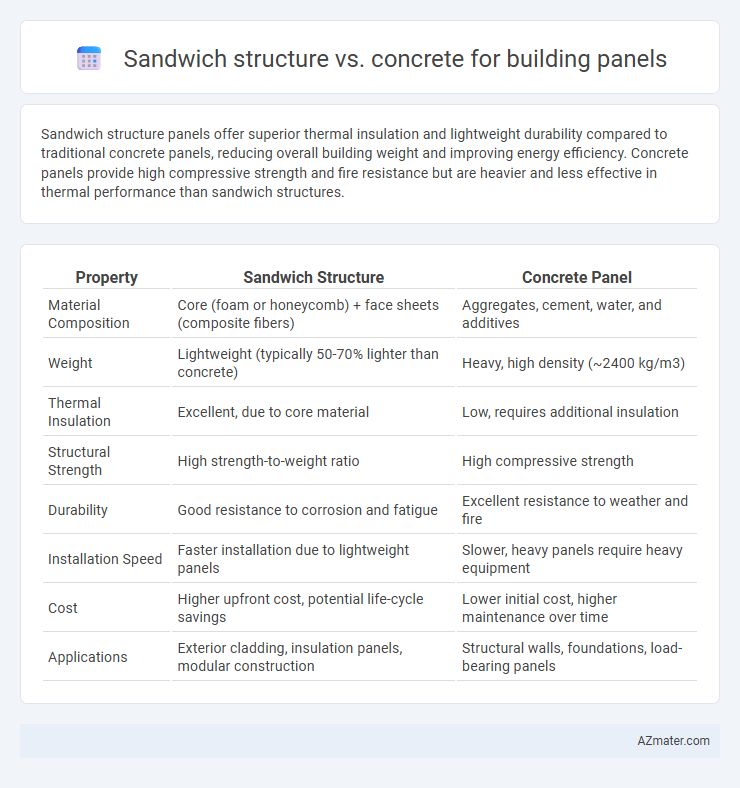Sandwich structure panels offer superior thermal insulation and lightweight durability compared to traditional concrete panels, reducing overall building weight and improving energy efficiency. Concrete panels provide high compressive strength and fire resistance but are heavier and less effective in thermal performance than sandwich structures.
Table of Comparison
| Property | Sandwich Structure | Concrete Panel |
|---|---|---|
| Material Composition | Core (foam or honeycomb) + face sheets (composite fibers) | Aggregates, cement, water, and additives |
| Weight | Lightweight (typically 50-70% lighter than concrete) | Heavy, high density (~2400 kg/m3) |
| Thermal Insulation | Excellent, due to core material | Low, requires additional insulation |
| Structural Strength | High strength-to-weight ratio | High compressive strength |
| Durability | Good resistance to corrosion and fatigue | Excellent resistance to weather and fire |
| Installation Speed | Faster installation due to lightweight panels | Slower, heavy panels require heavy equipment |
| Cost | Higher upfront cost, potential life-cycle savings | Lower initial cost, higher maintenance over time |
| Applications | Exterior cladding, insulation panels, modular construction | Structural walls, foundations, load-bearing panels |
Introduction to Building Panel Materials
Building panel materials significantly impact structural performance, thermal insulation, and cost-efficiency in construction. Sandwich panels consist of two outer facings bonded to a lightweight core, providing high strength-to-weight ratio and excellent thermal insulation compared to traditional concrete panels, which offer durability and fire resistance but tend to be heavier and less thermally efficient. Modern architectural applications increasingly prefer sandwich structures for their ease of installation and superior energy-saving capabilities in building envelopes.
Overview of Sandwich Structures
Sandwich structures consist of two strong outer layers bonded to a lightweight core, offering high stiffness-to-weight ratios compared to traditional concrete panels. These panels provide excellent thermal insulation, durability, and resistance to environmental stresses, making them ideal for energy-efficient building envelopes. Their lightweight nature reduces structural load and installation time, contributing to overall construction cost savings and enhanced performance.
Basics of Concrete Panels
Concrete panels are rigid building components composed of cement, aggregates, water, and admixtures that provide high compressive strength and durability. They offer excellent thermal mass, fire resistance, and sound insulation, making them suitable for load-bearing walls and floors in construction. Unlike sandwich panels, concrete panels typically require longer curing times and heavier support structures but excel in structural integrity and longevity.
Material Composition and Properties
Sandwich structures consist of two thin, strong face sheets bonded to a lightweight core such as foam or honeycomb, offering high stiffness-to-weight ratios and thermal insulation, while concrete panels are composed of cement, aggregates, and water, providing excellent compressive strength and durability. The composite nature of sandwich panels results in superior resistance to bending and reduced overall weight compared to the heavy mass and higher thermal conductivity of concrete. Material properties such as low density, high flexural modulus, and thermal resistance make sandwich panels ideal for energy-efficient, lightweight building applications, whereas concrete excels in load-bearing capacity and fire resistance.
Structural Strength and Performance Comparison
Sandwich panels offer superior strength-to-weight ratios compared to traditional concrete panels, enabling efficient load distribution and reduced structural mass. The core materials in sandwich panels, such as foam or honeycomb, provide excellent stiffness and impact resistance while maintaining thermal insulation properties. Concrete panels exhibit higher compressive strength but are prone to cracking under tensile stress, whereas sandwich panels deliver enhanced flexural performance and durability in dynamic loading conditions.
Thermal and Acoustic Insulation Differences
Sandwich panels feature layers of insulating foam or mineral wool between rigid facings, resulting in superior thermal resistance with lower thermal conductivity values compared to dense concrete panels. The lightweight core materials in sandwich panels also enhance acoustic insulation by absorbing sound waves more effectively than solid concrete, which tends to reflect sound, leading to higher noise transmission. Concrete panels provide mass-based soundproofing primarily through density, but sandwich panels deliver balanced thermal efficiency and superior noise reduction due to their composite layered structure.
Durability and Lifespan: Sandwich vs Concrete
Sandwich panels offer enhanced durability by combining rigid outer layers with insulating core materials, providing superior resistance to environmental stressors compared to traditional concrete panels. Concrete panels, while known for their compressive strength and longevity, are more susceptible to cracking and moisture ingress over time, which can reduce their effective lifespan without proper maintenance. The lifespan of sandwich panels often exceeds that of concrete when exposed to harsh climates due to corrosion resistance and reduced thermal expansion effects.
Weight, Handling, and Installation
Sandwich structure panels significantly reduce overall weight compared to traditional concrete panels, enhancing ease of handling and transport on construction sites. Their lightweight composition allows for faster installation, reducing labor costs and project timelines while maintaining adequate structural strength. Concrete panels, although durable, require heavy machinery for handling and longer curing times, limiting flexibility and efficiency during the installation process.
Cost Efficiency and Sustainability
Sandwich panels, featuring a core of insulating material bonded between two layers of structural board, offer superior thermal efficiency and reduced material usage compared to traditional concrete panels, resulting in lower lifecycle costs. Concrete panels, although durable and fire-resistant, often involve higher transportation and installation expenses due to their weight, impacting overall cost efficiency negatively. From a sustainability perspective, sandwich panels typically have a lower carbon footprint due to less raw material consumption and enhanced energy performance, while concrete's embodied energy and CO2 emissions remain significant challenges for eco-friendly building practices.
Best Applications for Each Panel Type
Sandwich panels, composed of two outer metal sheets with an insulating core, excel in applications requiring lightweight construction, thermal insulation, and rapid installation, making them ideal for cold storage, clean rooms, and modular buildings. Concrete panels offer superior structural strength, fire resistance, and durability, suiting them for load-bearing walls, high-rise buildings, and infrastructure projects. Selecting between sandwich and concrete panels depends on performance requirements such as thermal efficiency, load capacity, and construction speed.

Infographic: Sandwich structure vs Concrete for Building panel
 azmater.com
azmater.com